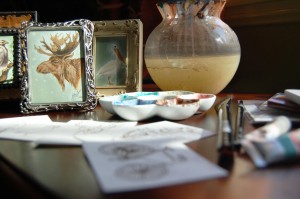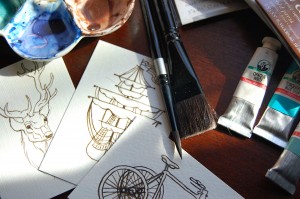There is nothing better as an artist than to see someone display your work and to know that they love and appreciate it. Whether art is a hobby or you earn a living with it, there are always opportunities to sell your art. If you are struggling with how to go about it, the ideas below can be combined to create your own strategy for marketing your work.
• Artist Cards, Editions and Originals (ACEO) – use as business cards to promote your work. Your original art on the front, your contact & product information on the back.
• Bookmarks – again, use as a business card with your art on one side and your information on the other. Bookmark tassel and sleeve sets can get you started.
• Promotional pieces – T-Shirts, coasters, mugs, etc. – Check out Cafe Press. Wear your art – “mobile marketing” – then hand out an ACEO or bookmark when someone is interested in your art.
• Mail your art
– Use postcards of your art to advertise your work, sell sets of postcards or give as gifts
– Envelope art – advertise as you send out your mail
• Sell prints. These days it is easy. Fine art printing companies are widely available on the Internet and elsewhere. Many of them do digital capture as well as the printing itself.
• Develop a blog or your own online gallery. At a minimum, get a simple web page where people can view your work and contact you – people expect this. Get a free hosted blog at WordPress.com. If you decide you want your own website, check out free web hosting here, then get free blogging software for your website at WordPress.org.
• Sell on eBAY or ETSY – great places to sell your specialty greeting cards or even original art. List your work on eBay to appeal to consumers who don’t have the time or inclination to pay gallery prices. Set a reserve price that assures you’ll get a decent return on your time.
• Art shows – This can be a great way to get your work seen in the local market. Galleries often host these shows, so they do all the advertising. See our recent blog article for information on shows and how to prepare for them. To find shows in your area you can go to festivalnet.com, or Google “craft show index”.
• Set up a booth at your local farmers market, flea market or swap meet to sell your work. This can be fairly inexpensive.
• Ask to have your art displayed at local libraries, restaurants, Barnes & Noble in the café area, etc.
• Sell through an online artist cooperative.
• Network – join museum or artists’ groups and local business community groups.
• Enter competitions.
• Display or sell your work at church & temple bazaars and holiday boutiques, convention centers and community centers.
• Approach companies that will sell your product. Just because you are an individual, don’t assume that companies won’t want your product. Check out Lady Bones.


